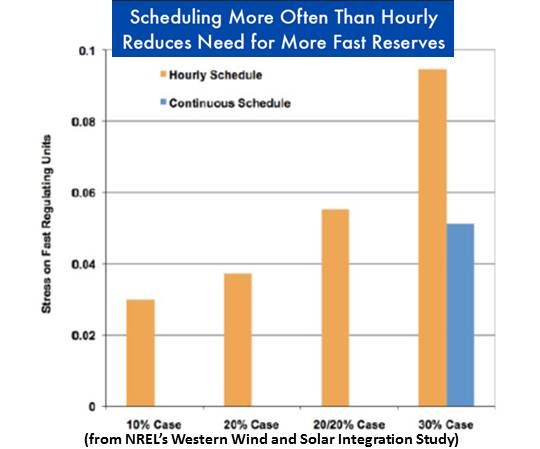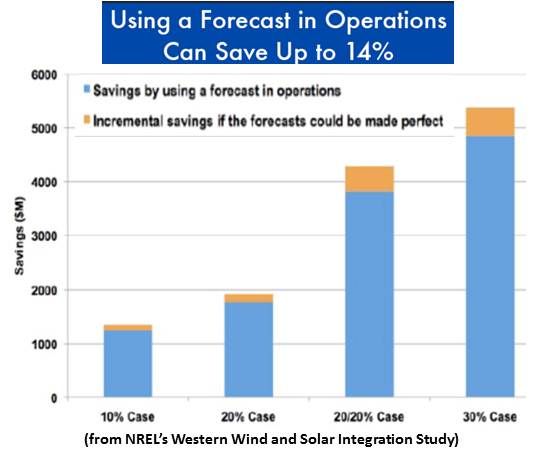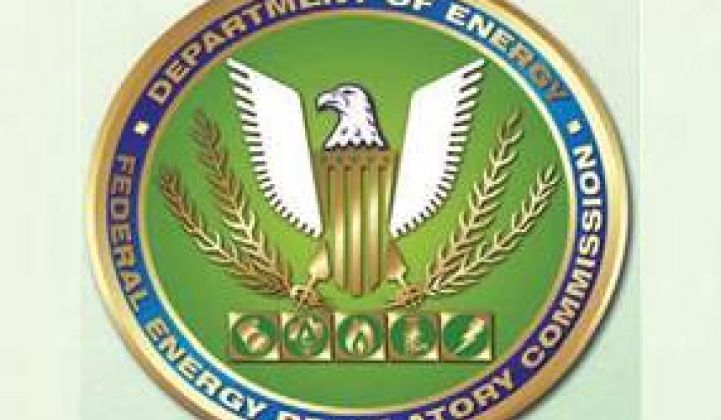Not long ago, grid operators only had to worry about coal, nuclear, natural gas and big hydro as sources of electricity generation. Except for the pollution, the threat of radioactive disaster, and blocking rivers, it was a simpler, more innocent time.
A day-ahead schedule with an hourly real-time update of dispatch in response to unexpected rising and falling demand worked fine for grid operators. The only forecasts they had to worry about were planned maintenance and major changes in weather.
Continued reliance today on such antiquated grid operating standards amounts to de facto discrimination against variable renewables like wind and solar.
To integrate variable renewables into a transmission system, sub-hourly scheduling and dispatch of generation, based on detailed forecasts of renewable resources and the state of the older power plants, is vital.
“Many of these grid operating practices were put in place decades ago to accommodate peculiar attributes of the fossil, nuclear, and hydroelectric power plants that made up nearly the entire generating fleet at the time,” the American Wind Energy Association (AWEA) and its allies wrote last fall in pre-decision comments on proposed rule changes by the Federal Energy Regulation Commission (FERC). “Attempting to fit variable renewable energy resources into these operating practices is often like trying to fit a round peg into a square hole.”

The proposed rule changes were part of an ongoing effort by FERC to push grid operators toward adapting to a changing resource mix.
Thanks to capabilities available to grid operators through smart transmission systems equipped with the newest computing and communications technology, it is entirely feasible to incorporate the schedule and forecast changes that will integrate higher levels of wind and solar and end discrimination against them.
FERC commissioners recently released their latest rulemaking. The new rules offer some advances but, according to the wind and solar industries, do not go far enough.
The new FERC rules:
- do require grid operators to offer sub-hourly (15-minute or shorter interval) scheduling;
- do not require them to do sub-hourly dispatch of generation; and
- do require renewables generators to report their (typically more accurate and detailed) resource forecasts to grid operators.
Such decision-making is an imperfectly incremental political process. “Variable energy resources make up an increasing share of new capacity coming on-line,” Obama-appointed FERC Chairman Jon Wellinghoff said. “This final rule eliminates undue burdens on these resources and will help transmission providers and their customers effectively manage the costs of integration.”
“Based on what was revealed,” said AWEA Senior Vice President for Public Policy Rob Gramlich of the new rules, “FERC got it partially right.”

There is debate as to whether the cost of implementing the changes will outweigh the benefits. AWEA argued, in its comments on the FERC proposal, that if grid operators persist in their old familiar ways, they will cost utility ratepayers, invite outages and risk security breaches.
Others question whether transmission systems are ready for the changes they are being asked to implement. “Do the regulator and the legislators have enough information about what this will take?” California transmission system official Jim Detmers recently asked about California’s mandate to integrate renewables. “I’m looking for them to answer the questions rather than just charge off and take us down the road.”
Authorities on transmission system operations say the most significant omission in the rulemaking is a requirement to use generation sources in the sub-hourly units in which dispatch can be planned. By continuing to dispatch at hourly intervals, grid operators will need to use a great deal more fossil fuel reserves. This could keep power prices high and neutralize the impact of renewables.
“We should be thinking seriously,” Detmers had said of California’s integration challenge, “about how much mass or spinning reserve we should maintain on the system.”
"A slew of recent studies," conservative energy writer and fossil fuel advocate Robert Bryce wrote, “show that wind-generated electricity likely won't result in any reduction in carbon emissions -- or that they'll be so small as to be almost meaningless."
One of Bryce’s key studies was a study of Xcel Energy’s integration of wind in Colorado. Xcel Environmental Policy Vice President Frank Prager dismissed Bryce’s claim. “Since 2007, we have added hundreds of megawatts of wind generation, and our overall emissions have declined."
National Renewable Energy Lab (NREL) modeling of the Eastern and Western U.S. transmission systems concluded that as much as 35 percent renewables will not increase fossil use or costs. But the kinds of changes FERC and the solar and wind industries want, those NREL studies argued, are crucial to high levels of integration.
This is a “dramatic makeover of the grid,” a former utility official with over 40 years of experience in energy policy recently opined to GTM. “If you’re a transmission planner and there is a blackout on your watch, that is a career-defining moment. So you get really passionate about some of this stuff and you don’t like change.”
But, he added, “people are going to have to change their minds about how they do things [because] we’re not very good at dealing with wind and solar and variable resources that come on and go off with nature and as the sun rises and sets.”




